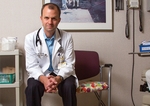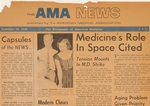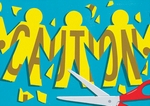profession
Evidence of surgery found in early colonial settlement
■ In 17th-century Jamestown, surgeons learned their trade through trial and error.
- WITH THIS STORY:
- » External links
The surgery wasn't a success, and the patient likely died. But the procedure 400 years ago is evidence of the earliest known surgery (and autopsy) in the English colonies in America.
Archaeologists announced last month that they had found a skull fragment in a 400-year-old trash pit at Jamestown, Va., the first permanent English settlement in North America.
Researchers said a surgeon tried to drill two holes in a man's skull with a trepan to relieve pressure on the brain. The procedure wasn't completed, probably because the patient died, and saw marks on the skull indicate that an autopsy was conducted later.
The skull fragment and medical objects discovered at the historic site validate documents indicating that surgeons, doctors and apothecaries were in Jamestown as early as 1607 to 1610.
"It adds to the historical context and the evolution of medicine and medical practice. Where we are today is a product of what came before," said Ashley H. McKeown, PhD, an assistant professor in the Anthropology Dept. at the University of Montana.
Surgeon Edward R. Laws, MD, president of the American College of Surgeons, agreed that the skull has a significant story to tell.
"It gives you a glimpse of surgery and medicine in colonial America that we didn't have before. I wish I could have been there watching," said Dr. Laws, professor of neurosurgery at the University of Virginia, who has visited Jamestown twice.
The section of skull, about 4 inches by 4¾ inches, was found in a bulwark trench from one corner of the James Fort site.
It was discarded there no later than 1610 as medical waste.
Deadly blow to the head
Dr. McKeown and Douglas W. Owsley, PhD, forensic osteologist at the National Museum of Natural History at the Smithsonian Institution in Washington, D.C., said the fragment was a piece of occipital bone from the back of a European man's skull. Researchers said they knew the skull had come from a man because of the shape of the bone and the muscle markings on the skull. They think the man was from Europe because the bone contained traces of lead, and eating and drinking from lead-glazed pottery or pewter was common in Europe.
The man's skull had been fractured by a blow to the back of his head, likely from a stone ax.
"The [patient] was probably beyond help when [the surgeon] started the procedure and was probably held down by a couple other individuals," said Bly Straube, senior curator of the Assn. for the Preservation of Virginia Antiquities.
Circular cut marks show the surgeon attempted to drill two holes in the skull. The bone has a skip mark.
"Somehow, [the surgeon] lost his place," Dr. McKeown said.
Physicians in the 17th century were academically trained, while surgeons learned their craft through apprenticeships, Straube said. "They were all on a learning curve," Straube said of the surgeons. "They had a lot less to work with [than today]."
Neurosurgeon James Tait Goodrich, MD, PhD, was fascinated by the discovery and said it spoke to the risks surgeons took.
"It's pretty amazing to think there was someone who was that cavalier in [an] open homestead. This was a barren outpost," said Dr. Goodrich, director of the division of pediatric neurosurgery at the Children's Hospital at Montefiore Medical Center in New York City.
Archaeologists have unearthed other medical artifacts at Jamestown that paint a portrait of medicine in colonial America. Discoveries at the James Fort site include a spatula mundani, an instrument that treated severe constipation with a spoon end used to withdraw hard excrement.
Also found was part of a bullet extractor as well as numerous pieces of pottery from apothecary jars, which contained herbs and medicines. Archaeologists believe that the medical tools were sent to Jamestown in a surgeon's chest put together by surgeon John Woodall.












